エヴァ・ユスティンとロマ民族
Eva Justin and the Roma people
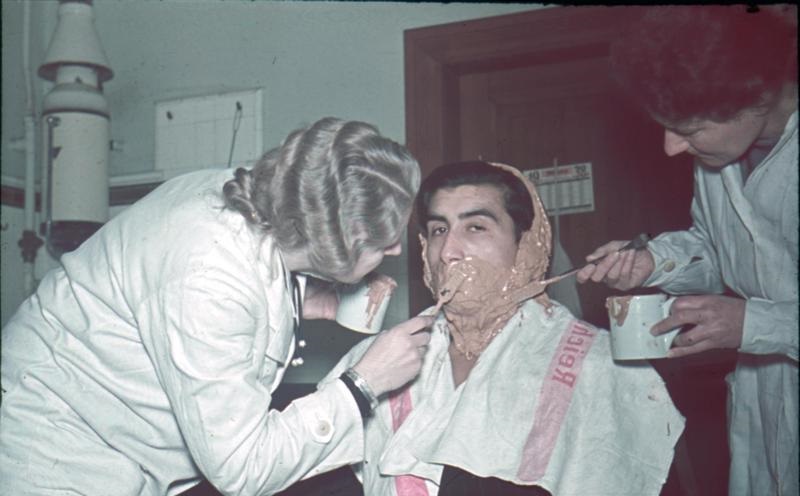

顔型をとるエヴァ・ユスティン(1936)/左がロベルト・リッターで中央はエヴァ・ユスティン(ハンブルグ 1938年)
エヴァ・ユスティンとロマ民族
Eva Justin and the Roma people


顔型をとるエヴァ・ユスティン(1936)/左がロベルト・リッターで中央はエヴァ・ユスティン(ハンブルグ 1938年)
エヴァ・ユスティン(Eva Justin, 1909年8月23日 - 1966年9月11日)は、ナチス時代に活躍したドイツの人類学者である。専門は科学的人種差別。彼女の研究は、シンティとロマの人々に対するナチスによ る犯罪行為に貢献した。1909年、鉄道職員の娘としてドレスデンに生まれ、ナチスの心理学者ロベルト・リッターの助手を務めた。看護婦としての訓練を受 け、1943年に大学の正規の手続きを踏まずにベルリン大学で人類学の博士号を取得した。オイゲン・フィッシャーが博士論文と最終試験を指導し、民族学者 のリチャード・サーンワルドが査読を行った[2]。ロマ語を話す彼女は、ロマやシンティの人々から信頼を得ていた。博士論文のタイトルは 「Lebensschicksale artfremd erzogener Zigeunerkinder und ihrer Nachkommen」(「ジプシーの子供とその子孫は、その種に不適切な方法で教育されたものである」)であった。
ロマやシンティに対する、ハインリッヒ・ヒムラーに よる絶滅命令は1942年12月16日におこなわれた。Sophie Ehrhardtは、 the Race Hygiene and Population Biology Research Center in the Reich Health Office に勤務し、1938年から1942年まで勤務した。研究所は、1945年までに2万4千人に対して「完全なロマ」「雑種ロマ」「非ロマ」の分類業務をおこ ない、そのデータは収容所移送、殺害処分を含む断種などの決定に使われた。
しかし、西ドイツ政府がシンティ・ロマへのジェノサイドを戦後公的にはじめて認めたのは、1982年のヘルムート・シュミット首相によってである(バーリーとヴィッパーマン 2001:105)。
エヴァ・ユスティンのホロコーストへの関与と彼女の略歴
| The children that
Justin studied had been selected for deportation, but this was delayed
until she completed her research and received her PhD. The children
were then sent to the "Gypsy family camp" at Auschwitz on 6 May 1944.
Soon after their arrival, Josef Mengele arrived at Auschwitz. Some of
the children were subjected to his experiments and most were eventually
killed in the gas chamber. Approximately 39 or 40 children that Justin
had studied were sent to Auschwitz in 1944, and all but four died
before the end of the war, many before her thesis was
published.Thirty-nine children from an orphanage in Mulfingen, who were
the subjects of Justin's doctoral thesis, were registered at Auschwitz
on 12 May 1944. She searched for anthropological subjects in
concentration camps. |
ユスティンが研究していた子どもたちは、強制送還の対象として選ばれて
いたが、彼女が研究を終えて博士号を取得するまで、強制送還は延期された。そして、子供たちは1944年5月6日にアウシュビッツの「ジプシー家族収容
所」に送られた。到着後すぐに、ヨーゼフ・メンゲレがアウシュビッツに到着した。そして、何人かの子供たちは彼の実験台にされ、最終的にはほとんどがガス
室で殺された。ユスティンが研究した約39、40人の子どもたちが1944年にアウシュビッツに送られ、4人を除く全員が終戦前に死亡し、その多くが彼女
の論文が出版される前に死亡した。ユスティンの博士論文の対象であるムルフィンゲンの孤児院の39人の子どもたちは、1944年5月12日にアウシュビッ
ツに登録されていた。彼女は、強制収容所で人類学の対象を探した。 |
| Justin was a senior member of
the Race Hygiene Research Center. She wrote in the foreword to a
research paper that she hoped to provide the basis for further racial
hygiene laws to stop the flow of "unworthy primitive elements" into the
German population. Her position was that Romani people could not be
assimilated because "they usually became asocial as a result of their
primitive thinking, and that attempts to educate them should be
stopped." Justin proposed sterilization for Romani people, except for
those with "pure Gypsy blood." She was present when the Sinti and Roma
deportations to concentration camps were organized. |
ユスティンは、人種衛生研究センターの幹部であった。彼女は研究論文の
序文で、ドイツ国民の中に「価値のない原始的要素」が流れ込むのを食い止めるために、さらなる人種衛生法の根拠を提供することを望んでいると書いている。
彼女の立場は、ロマ人は同化できない。「彼らは通常、原始的な考え方の結果、非社会的になり、彼らを教育する試みは止めるべき
」というものだった。ユスティンは、「純粋なジプシーの血」を持つ人を除いて、ロマニ族に不妊手術を施すことを提案した。彼女は、シンティとロマの強制収
容所への強制送還が組織されたときに立ち会った。 |
| In 1958, the Frankfurt district
attorney initiated an investigation into Justin's wartime actions, but
the investigation was closed in 1960, after the district attorney had
concluded that her actions were subject to the statute of limitations.
Frankfurt magistrates found insufficient evidence to prosecute Justin
in 1964, believing that Justin had not known her ideas would lead to
the children being sent to concentration camps and that survivors could
not specifically remember her striking them. Justin had based her work
on the ideas of Robert Ritter and no longer believed them. |
1958年、フランクフルト地方検事はユスティンの戦時中の行動につい
ての調査を開始したが、彼女の行動は時効であると地方検事が結論付けたため、1960年に調査は打ち切られた。1964年、フランクフルト地方検事は、
ジャスティンが自分の考えが子どもたちを強制収容所に送ることになるとは知らなかったこと、生存者は彼女が殴ったことを特に覚えていないと考え、ジャス
ティンを起訴するには証拠が不十分であると判断した。ユスティンは、ロバート・リッターの考えに基づいて仕事をしていたが、もはやそれを信じてはいなかっ
た(というのだ)。 |
| In post-war West Germany, Justin
worked as a psychologist for the Frankfurt police, even acting as a
consultant to the legal system for compensation cases for Holocaust
survivors. She died from cancer in 1966 in Offenbach am Main, a city on
the outskirts of Frankfurt. |
戦後の西ドイツでは、フランクフルト警察の心理学者として働き、ホロ
コースト生存者への補償事件の法制度の相談役も務めたユスティン、彼女は1966年、癌のためフランクフルト近郊の都市オッフェンバッハ・アム・マインで
死去した。 |
| "Eugenics underpinned the Nazi
race theories which saw the murder of over 10 million people from
“undesirable” groups, including Sinti (referred to in Nazi times as
“Gypsies”), during the Holocaust. Eva Justin, from Dresden, completed a
doctoral dissertation which examined a group of Sinti children of St
Josef’s Home in Mulfingen, Germany. She aimed to prove the racial
inferiority of these children; her work was done with no informed
consent, and the children were sent to Auschwitz after her experiments.
The study was supported by senior Nazis, supervised by Nazi
“scientists” and examined by committed Nazis. We argue that her work
was biased, poorly designed, and ultimately unethical, but was in
keeping with methods of the emerging disciplines of anthropology and
racial hygiene, in Germany and other countries, at the time. It is not
possible to say that her work caused the children to meet their deaths
(of the 39 children she included, only four survived); however, she did
reinforce the Nazi racial theories. It is unfortunate that one of the
first nurses in the world to receive a PhD did so through research
attempting to prove that a group of children were “racially inferior”
in support of National Socialism."- A nurse working for the Third
Reich: Eva Justin, RN, PhD. by Susan Benedict et al.
https://doi.org/10.1177/0967772016666684. Abstract |
優生学はナチスの人種理論を支え、ホロコーストではシンティ(ナチス時
代には「ジプシー」と呼ばれた)を含む「望ましくない」集団から1千万人以上の人々が殺害されたのである。ドレスデン出身のエヴァ・ユスティンは、ドイツ
のムルフィンゲンにある「聖ヨセフの家」のシンティ族の子供たちを調査し、博士論文を完成させた。彼女は、この子供たちの人種的劣等性を証明することを目
的としていた。彼女の研究は、インフォームドコンセントなしに行われ、実験後、子供たちはアウシュビッツに送られた。この研究は、ナチス幹部によって支援
され、ナチスの「科学者」によって監督され、献身的なナチスによって調査されたのである。私たちは、彼女の研究は偏ったものであり、計画が不十分で、最終
的には非倫理的であったと主張するが、当時ドイツや他の国々で新たに生まれた人類学や人種衛生の分野の手法と一致するものであった。彼女の研究が子供たち
を死に至らしめたとは言えないが(対象となった39人の子供のうち、生き残ったのは4人だけ)、彼女はナチスの人種理論を強化するものであった。世界で初
めて博士号を取得した看護婦の一人が、国家社会主義を支持し、ある子供たちが「人種的に劣っている」ことを証明しようとした研究によって、博士号を取得し
たことは残念なことである。 |
| Eva Hedwig Justin
(* 23. August 1909 in Dresden; † 11. September 1966 in Offenbach am
Main) war eine deutsche Rassenforscherin zur Zeit des
Nationalsozialismus. Sie arbeitete unter Robert Ritter sowohl im
Reichsgesundheitsministerium als auch nach 1948 im Gesundheitsamt der
Stadt Frankfurt. Sie nahm Untersuchungen an Häftlingen in
Jugendkonzentrationslagern vor und sorgte für deren Begutachtung. Mit
Interventionen bei der Polizei trug sie zum Porajmos bei, dem Genozid
an einem großen Teil der als „Zigeuner“ kategorisierten europäischen
Roma. |
エヴァ・ユスティン(Eva Hedwig Justin, *
1909年8月23日 in Dresden, † 1966年9月11日 in Offenbach am
Main)は、国家社会主義時代のドイツの人種研究者である。ロベルト・リッターのもとで、帝国保健省、そして1948年以降はフランクフルト市の保健局
に勤務していた。青少年強制収容所の囚人の検査を実施し、査定を受けるようにした。警察への介入により、ヨーロッパのロマの大部分が「ジプシー」とカテゴ
ライズされたポラージュモスの大量虐殺に加担した。 |
| Leben Eva Justin wurde als Tochter des Reichsbahnbeamten Karl Justin und seiner Ehefrau Magarethe geb. Ebinger in Dresden geboren. Bereits 1925 wurde sie Mitglied im Jungdeutschen Orden. Das Abitur machte sie 1933 im Alter von 24 Jahren am Luisenstift in Kötzschenbroda-Niederlößnitz. Ab 1934 nahm sie an einem Lehrgang für Krankenschwestern teil und wurde von Robert Ritter an die Universitätsnervenklinik in Tübingen geholt.[1] Im Jahr 1936, als Ritter zum Leiter der „Rassenhygienischen und Bevölkerungsbiologischen Forschungsstelle im Reichsgesundheitsamt“ (RHF) berufen wurde, nahm er Justin mit und machte sie zu seiner Stellvertreterin.[2] Sie immatrikulierte sich am 2. November 1937 in Berlin.[3] Justin, die Romanes beherrschte, erwarb sich das Vertrauen mancher Roma und Sinti. |
生涯 エヴァ・ユスティンは、ドレスデンで帝国軍将校カール・ユスティンとその妻マガレーテ(旧姓エビンガー)の娘として生まれた。1925年には早くもドイツ青年騎士団の一員となった。 1933年、24歳のときにケッチェンブローダ・ニーダーレーシュニッツのルイセンシュティフトでアビトゥアを取得した。1934年から看護師養成コース に通い、ロベルト・リッターによってチュービンゲンの大学精神病院に採用された[1]。1936年にリッターが「Rassenhygienische und Bevölkerungsbiologische Forschungsstelle im Reichsgesundheitsamt」(RHF)の代表に任命されると、ユスティンを連れていき彼の副官とした。 1937年11月2日にベルリンで卒業した[3]。 ロマニーを知るユスティンは、一部のロマやシンティから信頼を得ていた。 ※帝国保健省人種衛生・人口生物学研究センター(Rassenhygienische und Bevölkerungsbiologische Forschungsstelle im Reichsgesundheitsamt, RHF) |
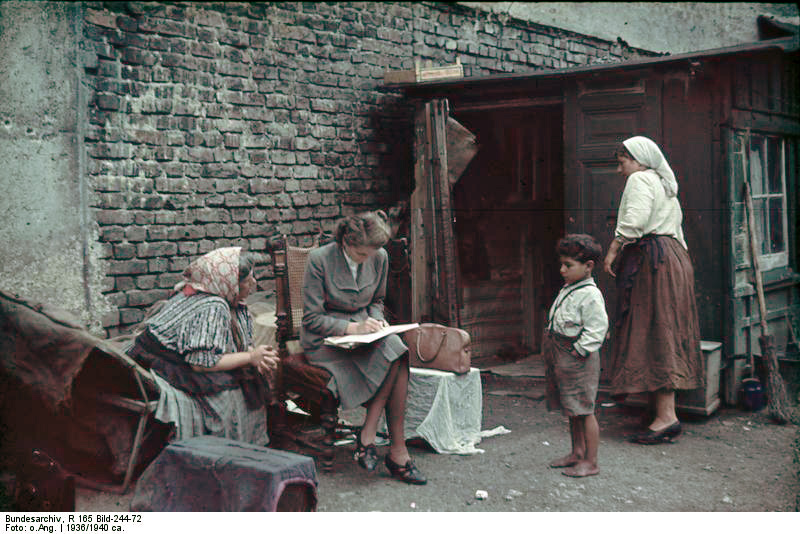 |
Eva Justin begutachtet im Rahmen ihrer Tätigkeit für die
Rassenhygienische Forschungsstelle des Reichsgesundheitsamtes zwei alte
Frauen und einen Jungen. Aufnahme von 1936. Bundesarchiv R 165 Bild-244-72, Eva Justin vor Wohnung.jpg エヴァ・ユスティンは、帝国保健局人種衛生学研究センター(Rassenhygienische Forschungsstelle des Reichsgesundheitsamtes)の仕事の一環として、2人の老女と少年を診察している。1936年当時の写真。 |
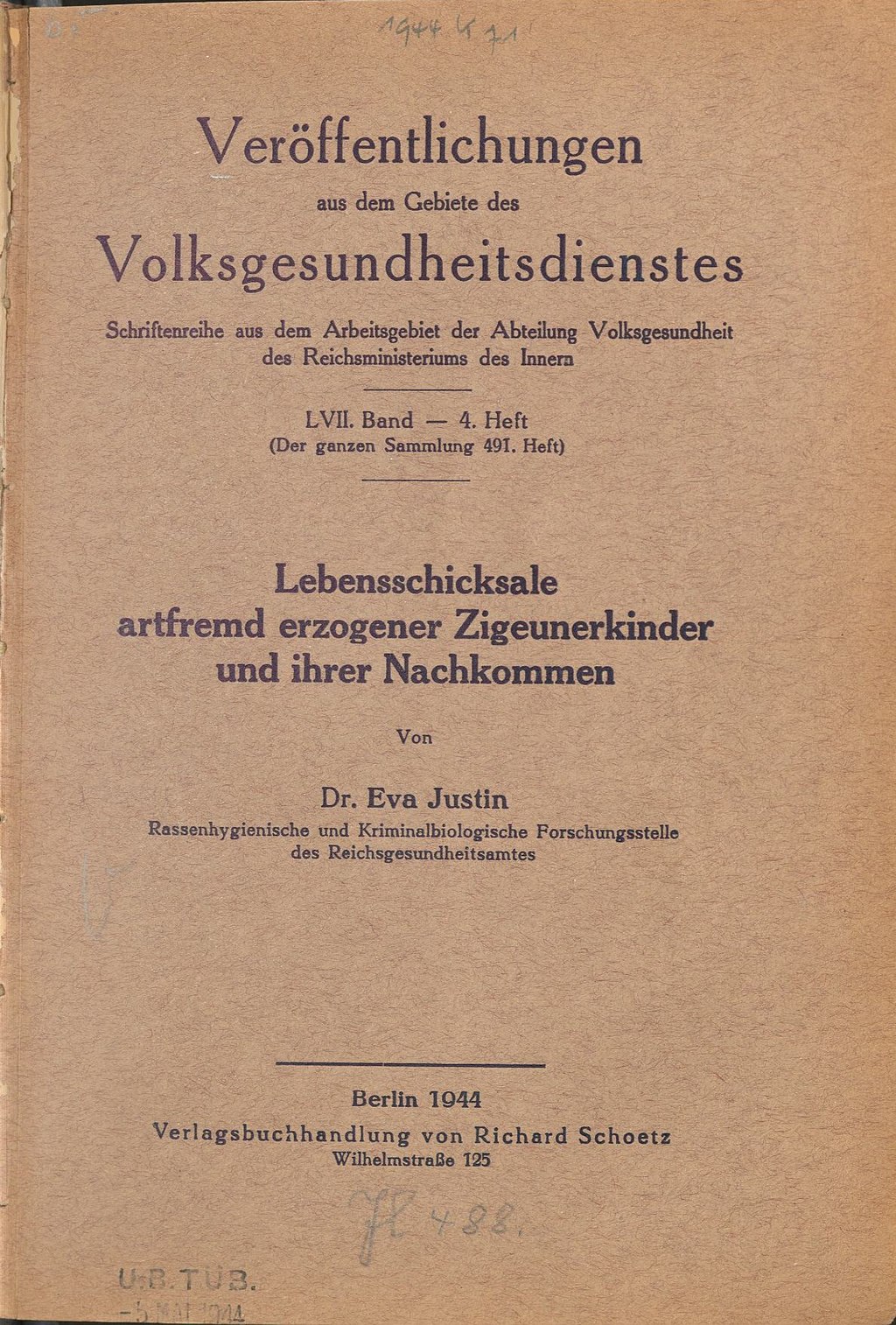 |
Lebensschicksale artfremd erzogener Zigeunerkinder und ihrer Nachkommen (1944) |
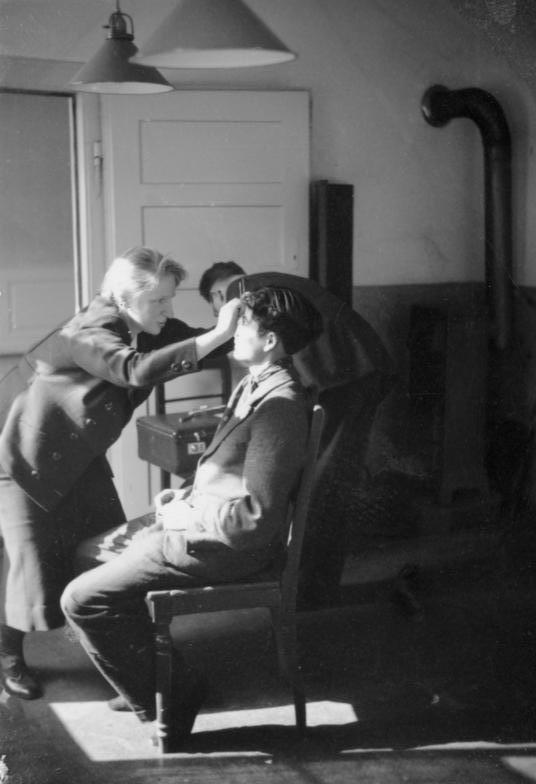 |
Eva Justin beim Vermessen eines
Sinto für die Rassenhygienische Forschungsstelle in den Räumlichkeiten
der Kripo Karlsruhe. Bundesarchiv Bild 146-1989-110-31, Eva Justin ---
bei Schädelmessung.jpg カールスルーエCIDの敷地内にあるRassenhygienische ForschungsstelleのSintoを測定するEva Justin。 |
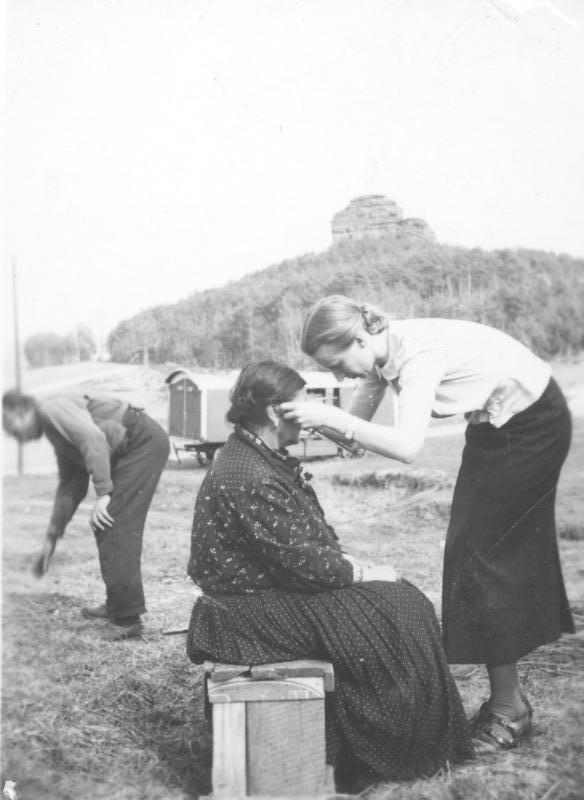 |
Eva Justin bei der „Feldforschung“ 1938 in Stein in der Pfalz. Diese Erhebungen flossen in die Rassegutachten ein. 1938年、プファルツ州シュタインで「実地調査」中のエヴァ・ユスティン。これらのアンケートは、人種評価に反映された。 Bundesarchiv Bild 146-1986-044-10, Stein-Pfalz, Eva Justin bei Schädelmessung.jpg |
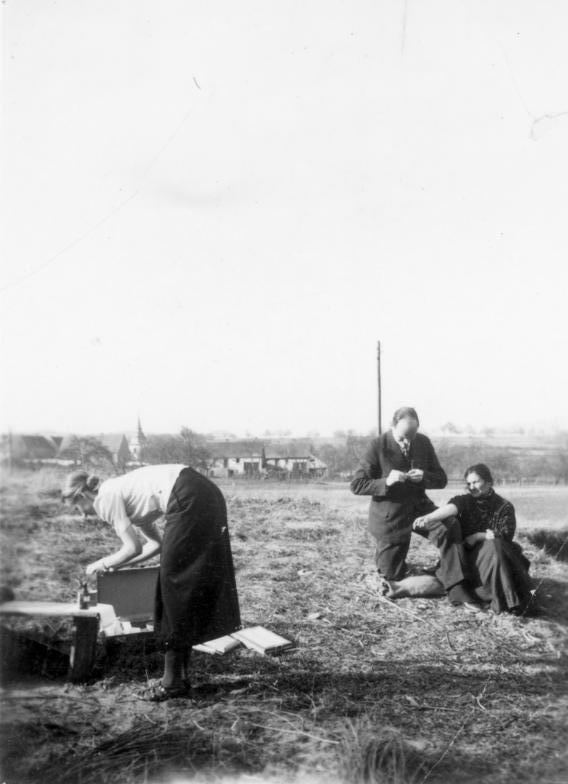 |
Eva Justin assistiert Ritter bei einer Blutabnahme, 1938 in Stein in der Pfalz. リッターの血液サンプルを採取するエヴァ・ユスティン(1938年、プファルツ州シュタインにて)。 Bundesarchiv Bild 146-1991-014-11, Stein-Pfalz, Ritter und Justin bei Blutabnahme.jpg |
| Promotion Justin konnte keinen Hochschulabschluss vorweisen. Um ihr dennoch eine Promotion zu ermöglichen, setzte man sich in ihrem Fall mehrfach über Formalien hinweg. Ein ursprünglich von ihrem Hochschullehrer Kurt Gottschaldt vorgeschlagenes Thema ignorierte sie und brach auch die Besuche seiner Vorlesungen ab. Anfang März 1943 legte sie stattdessen eine Arbeit „Lebensschicksale artfremd erzogener Zigeunerkinder und ihrer Nachkommen“ vor – ein Thema, das mit keinem Professor der Universität vereinbart worden war.[4] Ihre Promotion bedurfte also prominenter Unterstützung. Sie besuchte, von Robert Ritter unterstützt, den emeritierten Eugeniker und ehemaligen NS-Rektor der Berliner Universität Eugen Fischer bei einem Kuraufenthalt in Baden-Baden. In einem Brief vom 4. März 1943 an „seine“ alte Universität bezeichnete Fischer die Psychologiestudentin Justin als Anthropologin. Am 12. März nahm die Universität die Dissertation an. Als indirekter Doktorvater sprang Ritter ein, der nicht zur Betreuung von Dissertationen berechtigt war. Gutachter der Dissertation waren Richard Thurnwald und Ritter, abschließend Fischer. In ihrem Schreiben zur Promotion berief sich Justin auf weitere Protektion von Hans Reiter, dem Leiter des Reichsgesundheitsamtes, Herbert Linden vom Reichsministerium des Innern und Paul Werner, der im Reichskriminalpolizeiamt für vorbeugende Verbrechensbekämpfung zuständig war. Die mündliche Prüfung fand am 24. März zwischen 9:15 und 10:15 in Ritters Privatwohnung statt; Fischer, der Justin in Anthropologie u. a. über Rothaarige prüfte, unterbrach dafür seine Kur. Wolfgang Abel führte eine „weltanschauliche“ Besprechung durch, der Völkerkundler Thurnwald befragte sie zu „afrikanischen Wildbeutervölkern“. Fischer gab ihr ein „knappes gut“, Abel: „sehr gut“, Thurnwald: „gut“.[5] Während ihres Studiums besuchte sie nach eigenen Angaben Vorlesungen von prominenten NS-Professoren und Verfechtern des erbpathologischen Paradigmas: Wolfgang Abel, Eugen Fischer, Kurt Gottschaldt, Hans F. K. Günther, Günther Hertwig, Paula Hertwig, Fritz Lenz, Wilhelm Emil Mühlmann, Hans Reinerth, Hans Reiter, Robert Ritter, Rupp, Bruno Kurt Schultz, Eduard Spranger, Richard Thurnwald und Otto Wuth. Die „völkerkundliche Feldforschung“ (Thurnwald) für ihre Dissertation fand im Frühherbst 1942 für sechs Wochen im katholischen Kinderheim St. Josefspflege in Mulfingen statt, wo insgesamt etwa 70 Heimkinder lebten. Darunter fanden sich auch 40 zwischen sieben- und 16-jährige Sinti-Kinder von Mulfingen, die aufgrund verschiedener behördlicher Zwangsmaßnahmen zusammengezogen worden waren. Die „deutschblütigen“ Kinder des Heimes wurden von Justin nicht beachtet.[6] Grundlage für die Zusammenführung in diesem Heim war der württembergische Heimerlass für „Zigeunerkinder“ vom 7. November 1938.[7] Ein Teil der Eltern war aufgrund von Heinrich Himmlers „Asozialenerlass“ vom 14. Dezember 1937[8] ins KZ eingewiesen, weitere Eltern waren infolge des „Auschwitz-Erlasses“ vom 16. Dezember 1942 deportiert worden oder Kinder waren aufgrund der Denunziation einer NSV-Fürsorgerin ihren Eltern entzogen und der Heimerziehung zugeführt worden.[6][9] Auf die Sinti-Kinder von Mulfingen wurde Himmlers Auschwitz-Erlass zunächst nicht angewendet.[10] Die Rohabzüge der Dissertation wurden am 5. November 1943 verschickt, die endgültige Druckfassung am 9. März 1944 ausgeliefert. Damit war Justins Promotionsverfahren abgeschlossen. Wenige Tage später, „jetzt konnte Justin sicher sein, dass sie ihr ‚Untersuchungsgut‘ nicht mehr benötigte“ (Gilsenbach), gab die Polizei dem Kinderheim bekannt, dass ein Abtransport der Kinder in ein „Zigeunerlager“ geplant sei.[11] Die 39 Sinti-Kinder wurden am 9. Mai 1944 deportiert, sie trafen am 12. Mai 1944 im Zigeunerlager Auschwitz ein. Im August 1944 wurden diese Kinder bis auf vier im KZ Auschwitz-Birkenau in der Gaskammer umgebracht.[12] In ihrer Dissertation[13] kam Justin zu dem Ergebnis, dass „Zigeuner“ durch ihre „mangelhaften Anpassungsfähigkeiten in der Regel doch mehr oder weniger asozial“ würden. „Fast alle Zigeuner und Zigeunermischlinge sind durch eine mehr oder weniger große Haltschwäche […] gefährdet“. Es würde immer neues „minderwertiges Erbgut“ in den deutschen „Volkskörper“ einsickern. „Das deutsche Volk braucht aber zuverlässige und strebsame Menschen und nicht den zahlreichen Nachwuchs dieser unmündigen Primitiven.“ Aus diesen Gründen trat sie vehement für die Zwangssterilisation von Sinti- und Romafrauen ein. |
博士号 ユスティンは、大学を卒業していない。それにもかかわらず、博士号を取得するために、彼女の場合、何度も手続きを無視された。 大学の恩師クルト・ゴットハルトから提案されたテーマを無視し、彼の講義にも出席しなくなった。その代わりに、1943年3月初めに 「Lebensschicksale artfremd erzogener Zigeunerkinder und ihrer Nachkommen」(「種とは異なる環境で育てられたジプシーの子供とその子孫の運命」)という論文を提出したが、大学のどの教授とも意見が一致しな かった。 このため彼女の博士課程には著名な支援が必要であった[4]. 彼女は、ロバート・リッターの支援で、バーデン・バーデンでの温泉滞在中に、ナチス時代のベルリン大学名誉学長で優生学者でもあったオイゲン・フィッ シャーを訪ね、その時の様子を語った。1943年3月4日付の「自分の」母校への手紙の中で、フィッシャーは心理学を学ぶジャスティンのことを人類学者と 呼んでいる。3月12日、同大学は論文を受理した。学位論文の指導をする権限のないリッターが、間接的な博士課程の指導者として乗り込んできた。 Richard ThurnwaldとRitterが論文の審査員で、Fischerが最終審査員だった。 ユスティンは、博士号取得のための手紙の中で、帝国保健局長のハンス・ライター、帝国内務省のヘルベルト・リンデン、帝国刑事警察局で予防犯罪対策を担当していたパウル・ヴェルナーからさらなる保護を受けることを呼びかけている。 口頭試問は3月24日の9時15分から10時15分まで、リッターの私室で行われた。人類学で赤毛についてユスティンの試験をしていたフィッシャーは、そ のために彼の治療を中断してしまったのだ。ヴォルフガング・アベルは「世界的な」議論を行い、民族学者トゥルンヴァルトは「アフリカの野蛮な人々」につい て質問した。フィッシャーは「かろうじて良い」、アベルは「非常に良い」、サーンワルドは「良い」と評価した[5]。 彼女自身の説明によると、彼女は留学中、ナチの著名な教授や遺伝的病理学的パラダイムの提唱者であるヴォルフガング・アベル、オイゲン・フィッシャー、ク ルト・ゴットシャルト、ハンス・F・K・ギュンター、ギュンター・ヘルトヴィヒ、ポーラ・ヘルトヴィヒ、フリッツ・レンツ、ヴィルヘルム・ミル・ミューマ ン、ハンス・ライナート、ハンス・ライター、ロベルト・リッター、ルップ、ブルーノ・カート・シルツ、エドワード・スプランジェ、リチャード・トゥルンバ ルトおよびオット・ヴートによる講義を受けているとのことです。 論文のための「民族学的現地調査」(トゥルンヴァルト)は、1942年初秋の6週間、ムルフィンゲンのカトリック児童養護施設「聖ヨセフシュプレゲ」で行 われ、合計約70人の家庭児童が生活していた。その中には、当局の様々な強制措置によって検挙された7歳から16歳のムルフィンゲン出身のシンティ族の子 供たち40人も含まれていた。このホームの「ドイツ血統」の子どもたちはジャスティンに無視された[6]。このホームでの一斉検挙の根拠は、1938年 11月7日の「ジプシーの子どもたち」に対するヴュルテンベルク州のホーム令であった[7]。 1937年12月14日のハインリッヒ・ヒムラーの「非社会的令」[8]に基づいて強制収容所に送られた親や、1942年12月16日の「アウシュビッツ 令」によって国外追放された親、NSV福祉官の非難に基づいて親から子供を引き取って家庭教育を受けることになった者もいた[6][9] ヒムラーのアウシュビッツ令は当初マルフィンゲンのシンティ族の子供には適用されていない[10]. 1943年11月5日に学位論文のラフが発送され、1944年3月9日に最終的な印刷物が届けられた。これで、ユスティンの博士号取得手続きは終了した。 数日後、「これでユスティンはもう『検査材料』を必要としないと確信できた」(ギルゼンバッハ)ので、警察は児童館に「ジプシー収容所」への移送が計画さ れていると発表した[11] 39人のシンティの子供たちは1944年5月9日に移送され、5月12日にジプシー収容所のアウシュヴィッツに到着した。1944年8月、これらの子ども たちのうち4人を除く全員がアウシュビッツ・ビルケナウ強制収容所のガス室で殺害された[12]。 ユスティンは論文[13]で、「ジプシー」はその「適応能力の欠落」によって、結局は多かれ少なかれ反社会的になるのだという結論に達した。"ほとんどす べてのジプシーとジプシーの雑種は、多かれ少なかれホールドの大きな弱点によって危険にさらされている[...]"と述べた。ドイツの「民衆の体」には、 常に新しい「劣等遺伝物質」が染み込んでいくのである。"しかし、ドイツ国民が必要としているのは、信頼できる努力する人々であって、このような未熟な原 始人の多数の子孫ではないのです。" そのため、彼女はシンティやロマの女性の強制不妊手術を激しく主張した。 |
| Gutachten und Arbeit in der RHF Nach 1943 arbeitete Eva Justin weiter als wissenschaftliche Assistentin in der RHF. Dort unterzeichnete sie allein zwischen Februar und Oktober 1944 1320 Rassegutachten. So schrieb sie an die staatliche Kriminalpolizei Berlin am 10. Juli 1944 über die rassische Zuordnung einer Familie von fünf Musikern aus Ungarn: „Während das Äußere der Familienangehörigen nicht gerade typisch zigeunerisch ist, sondern – abgesehen von der Mutter – an Neger-Bastarde denken läßt, sprachen Gestik, Affektivität und Gesamtverhalten nicht nur für artfremde, sondern gerade auch für zigeunerische Herkunft. Die unechte Art scheinbar urbanen Auftretens, die Anpassung an sich flacher emotioneller Regungen an die jeweilige Umweltwirkung, die Uneinsichtigkeit und Urteilsschwäche gegenüber sachlichen Erwägungen und Folgerungen, die Standpunktlosigkeit und Unfestigkeit innerer Stellungnahme zeugen bei aller Schläue und Verschlagenheit von einer im Kern vorhandenen hochgradigen Naivität und Primitivität, wie man sie in dieser gelockerten Art bei sesshaften Europäern mit gezüchtetem Arbeitssinn nicht trifft.[14]“ |
専門家の意見とRHFでの仕事 1943年以降も、ユスティンはRHFで科学助手として働き続けた。そこで、1944年2月から10月までの間だけでも、1320件の人種差別報告書に署 名している。例えば、彼女は1944年7月10日、ベルリン国家刑事警察に、ハンガリーから来た5人の音楽家一家の人種分類について手紙を出している。 「家族の外見は典型的なジプシーではなく、母親を除けば黒人の私生児(バスタード) を思わせるが、仕草、感情、全体の振る舞いは非ジプシーだけでなく、特にジプシー出身であることを物語っている」。一見都会的な外観の不真面目なやり方, 浅薄な感情的衝動のそれぞれの環境効果への適応,事実に基づく考察と結論に直面したときの洞察力の欠如と判断力の弱さ,視点の欠如と内心の意見の固さの欠 如は,その抜け目のなさと悪巧みのために,その中核にある高度の素朴さと原始性を証明している。"この種のことは,教養ある労働感覚のある落ち着いたヨー ロッパ人には,こんなゆったりしたやり方で見つけることはできないだろう[14]..」. |
| Arbeit in Jugendkonzentrationslagern 1943 waren Ritter und Mitarbeiterinnen kriegsbedingt von Berlin auch nach Fürstenberg/Havel umgezogen und hatten dort in der Sicherheitspolizeischule Drögen neues Quartier gefunden. Am anderen Ortsende von Fürstenberg lag das Frauenkonzentrationslager Ravensbrück. In den „Jugendschutzlagern“ Moringen für männliche und Uckermark für weibliche Häftlinge waren Ritter und Justin für die Begutachtung der Jugendlichen zuständig.[15] |
青少年強制収容所での作業 1943年、リッターたちは戦争のためにベルリンからフュルステンベルク/ハーフェルに移り、ドレーゲン治安警察学校に新たな宿舎を見つけたのだった。 フュルステンベルクの反対側には、ラーベンスブリュック女子強制収容所がありました。男子囚人のための「青少年保護収容所」モリンゲンと女子囚人のための ウッカーマークでは、リッターとユスティンが青少年の評価を担当した[15]。 |
| Nachkriegszeit Nach dem Ende des NS-Regimes bezeichnete Justin sich im Fragebogen des Entnazifizierungsverfahrens als „politisch nicht belastet“ und gab lediglich die Mitgliedschaft im Roten Kreuz und der Arbeitsfront zu. Im März 1948 wurde sie, obwohl sie niemals psychologisch mit Kindern gearbeitet hatte und auch kein Examen oder einen sonstigen Abschluss in Psychologie besaß, als Kinderpsychologin in Frankfurt am Main angestellt. Ihr Vorgesetzter war wiederum Robert Ritter, der seit dem 1. Dezember 1947 für die Stadt Frankfurt arbeitete. In der Folgezeit erstellte sie psychologische Gutachten über schwererziehbare Kinder. Justin und Ritter gaben in dieser Zeit auch die von ihnen unterschlagenen Akten des Reichsgesundheitsamtes, also die Planungsunterlagen des Völkermordes an den europäischen Roma, an Polizeibehörden und ehemalige Mitarbeiter der Forschungsstelle weiter. 1958 ermittelte die Frankfurter Staatsanwaltschaft unter der personellen Zuständigkeit des hessischen Generalstaatsanwalts Fritz Bauer gegen Justin und verkündete, das Verfahren solle „die nationalsozialistischen Vernichtungsmaßnahmen gegen Zigeuner aufklären“.[16] Nach umfangreicher Beweiserhebung konstatierte die Staatsanwaltschaft zwar, dass die von Eva Justin angefertigten „Rassenhygiene-Gutachten“ über Roma der Gruppen „Sinte“, „Gelderari“, „Lallerie“, „Lowari“, „Roma aus Ungarn“ die Grundlage für deren Deportation nach Auschwitz und anschließende Ermordung gewesen seien, konnte aber nicht nachweisen, dass Justin die Folgen ihres Tuns gekannt habe. Andere zweifelsfrei bewiesene Handlungen wie die Zwangssterilisationen wurden als verjährt eingestuft. Im Dezember 1960 stellte die Staatsanwaltschaft das Ermittlungsverfahren gegen Justin ein. Bis 1962 begutachtete Justin für die Stadt Frankfurt „Zigeuner“, darunter auch solche, die sie vor 1945 für die Rassenhygienische Forschungsstelle begutachtet hatte. Aufgrund eines Fernsehfilms von Irmgard und Valentin Senger wurde sie versetzt.[17] 1963 trat Justin zum katholischen Glauben über. 1964 nahm sie Feldforschungen in einem Wohnwagen- beziehungsweise sogenannten „Zigeunerlager“ bei Frankfurt-Bonames vor und war danach als Angestellte der Universitäts-Nervenklinik in Frankfurt am Main tätig.[18] Im September 1966 starb sie an Krebs. |
戦後 ナチス政権崩壊後、ユスティンは、脱ナチス化の質問書に「政治的な罪はない」と記述し、赤十字と労働戦線のメンバーであることだけは認めている。 1948年3月、子どもたちと心理学的な仕事をしたことがなく、心理学の試験やその他の学位も持っていなかったが、フランクフルト・アム・マインで児童心 理学者として採用されることになった。彼女の上司は、1947年12月1日からフランクフルト市に勤務していたロバート・リッター氏である。その後、育て にくい子どもの心理報告書を作成。この間、ユスティンとリッターは、自分たちが流用した帝国保健局のファイル、すなわちヨーロッパ・ロマの大量虐殺の計画 文書を、警察当局や研究センターの元職員に渡している。 1958年、フランクフルト検察庁はヘッセン州検事長フリッツ・バウアーの個人的管轄権のもとにジャスティンを調査し、「国家社会主義者のジプシーに対す る絶滅措置を明らかにする」ための手続きであると発表しました。 [16] 広範な証拠収集の後、検察側は、エヴァ・ユスティンが作成した「シンテ」、「ゲルデラリ」、「ラレリ」、「ローアリ」、「ハンガリーからのロマ」というグ ループのロマに関する「人種衛生報告」が、アウシュヴィッツへの追放とその後の殺人の根拠となったと述べているが、ユスティンが自分の行動の結果を知って いたということは証明できなかった。その他、強制不妊手術など、疑いの余地がないことが証明されている行為については、時効とされた。1960年12月、 検察庁はユスティンに対する捜査を打ち切った。 1962年まで、ユスティンはフランクフルト市のために「ジプシー」を鑑定し、その中には1945年以前にRassenhygienische Forschungsstelleのために鑑定したジプシーも含まれていた。イルムガルトとヴァレンティン・ゼンガーが製作したテレビ映画がきっかけで移 籍した[17]。 1963年、ユスティンはカトリックに改宗した。1964年、フランクフルト・ボナームズ近郊のキャラバン、いわゆる「ジプシー・キャンプ」で野外調査を行い、その後フランクフルト・アム・マインの大学神経科クリニックに勤務した[18]。1966年9月に癌で死亡。 |
| Literatur Horst-Peter Wolff: Biographisches Lexikon zur Pflegegeschichte. Elsevier, Urban&FischerVerlag, 2001, ISBN 3-437-26670-5. Reimar Gilsenbach: Wie Lolitschei zur Doktorwürde kam. In: Wolfgang Ayaß, Reimar Gilsenbach, Ursula Körber u. a. (Hrsg.): Feinderklärung und Prävention. Kriminalbiologie, Zigeunerforschung und Asozialenpolitik (= Beiträge zur nationalsozialistischen Gesundheits- und Sozialpolitik, Bd. 6). Rotbuch, Berlin 1988, ISBN 3-88022-955-4. Jessica Hoffmann: Dahlemer Erinnerungsorte. Frank & Timme, 2007. ISBN 3-86596-144-4. Kathrin Kompisch: Täterinnen. Frauen im Nationalsozialismus. Böhlau Verlag, Köln 2008, ISBN 978-3-412-20188-3, S. 83. Ernst Klee: Das Personenlexikon zum Dritten Reich. Fischer, Frankfurt am Main 2007, ISBN 978-3-596-16048-8. Johannes Meister: Die „Zigeunerkinder“ von der St. Josefspflege in Mulfingen. In: 1999. Zeitschrift für Sozialgeschichte des 20. und 21. Jahrhunderts. Nr. 2 (1987), S. 14–51. |
|
| https://de.wikipedia.org/wiki/Eva_Justin |
https://www.deepl.com/ja/translator |
【参照ページ】ユスティンの上司であったロベルト・リッターとロ マ民族(→「ロベルト・リッター」)
Robert Ritter (14 May 1901 – 15 April 1951) was a German racial scientist doctor of psychology and medicine, with a background in child psychiatry and the biology of criminality. In 1936, Ritter was appointed head of the Racial Hygiene and Demographic Biology Research Unit of Nazi Germany's Criminal Police, to establish the genealogical histories of the German "Gypsies", both Roma and Sinti, and became the "architect of the experiments Roma and Sinti were subjected to."[1] His pseudo-scientific "research" in classifying these populations of Germany aided the Nazi government in their systematic persecution toward a goal of "racial purity".
ロベルト・リッター(1901年5月14日 -
1951年4月15日)は、ドイツの人種科学者で、児童精神医学と犯罪の生物学を専門とする心理学と医学の博士であった。1936年、リッターはナチス・
ドイツの犯罪警察の人種衛生・人口生物学研究班の班長に任命され、ドイツの「ジプシー」であるロマ人とシンティ人(シンティ・ロマ)の系譜を確定し、「ロマ人とシンティ人が受ける実験の設計者」
となった。彼の疑似科学的な「研究」は、ドイツのこれらの人口を分類し、ナチス政府が「人種の純化」という目標に向かって組織的に迫害を行うことを積極的
におこなった。
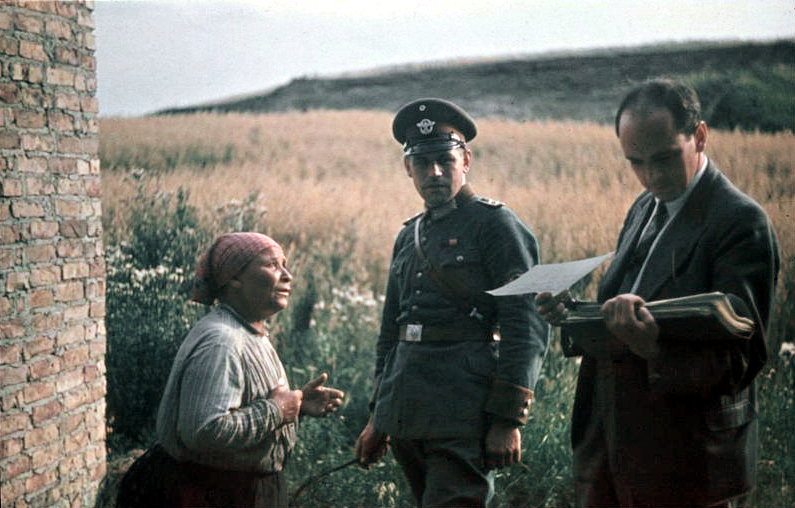
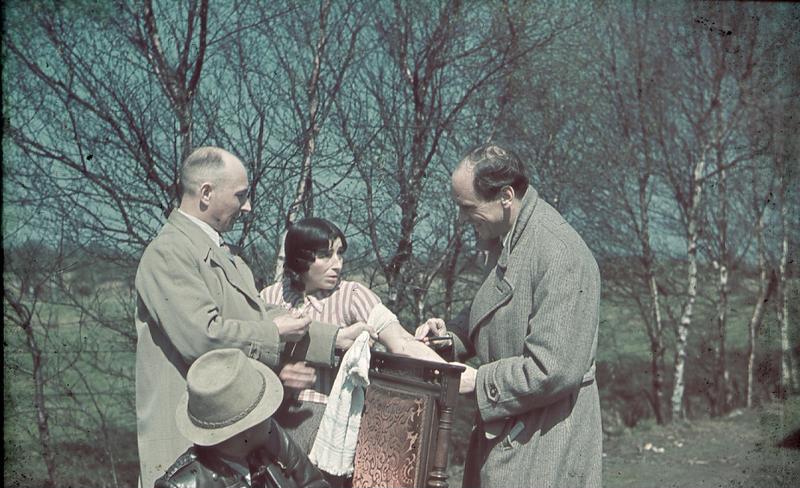
ブンデス・アーカイブ資料の説明:Dr.
Robert Ritter mit alter Frau und Polizist Dr. Robert Ritter mit
Aktenmappe und einer alten Frau (Sinti/Roma?), und Inspektor (?) der
Ordnungspolizei Abgebildete Personen: Ritter, Robert Dr.:
Rassenforscher, Leiter des Reichsgesundheitsamtes, Deutschland ( GND
119015501 )
| Ritter was born in 1901 in Aachen, Germany. He attended an exclusive secondary school, as well as a Prussian military academy. After a stint in the German Freikorps, Ritter began his formal education studying at various universities.In 1927, Ritter received his doctorate in educational psychology at the University of Munich. Post-doctorate, Ritter continued his education and received a medical degree from Heidelberg University in 1930, and was medically licensed the same year. In 1934, two years before being appointed as head of the German police's racial hygiene research unit, Ritter received his specialist certification in child psychology, studying the inheritability of criminality. He completed part of his residence in the University of Tübingen. | 【学
歴】リッターは1901年、ドイツのアーヘンに生まれた。1901年、ドイツのアーヘンで生まれ、高級中学校とプロイセン陸軍士官学校に通う。1927
年、ミュンヘン大学で教育心理学の博士号を取得。1927年、ミュンヘン大学で教育心理学の博士号を取得。1930年にはハイデルベルク大学で医学博士号
を取得し、同年医師免許を取得した。1934年、ドイツ警察の人種衛生研究部門の責任者に任命される2年前に、リッターは児童心理学の専門家資格を取得
し、犯罪性の遺伝を研究した。彼は、チュービンゲン大学でも一時的に滞在をして研究を成し遂げた。 |
| Ritter
and the Sterilization Law of 1933 ; Nazi seizure of power in 1933
allowed the party to transform their ideology of racial purity into
policy. The Law for the Prevention of Genetically Diseased Offspring
was put into effect New Year's Day, 1934, and included compulsory
sterilization of individuals who, according to medical knowledge, were
likely to pass on to their offspring a serious physical or mental
disorder. Besides a diagnosed medical disorder, citizens would also be
sterilized for being classified as asocial. An asocial diagnosis was
often associated with having "moral" or "disguised mental retardation",
despite showing no deficit in intelligence. Ritter was responsible for
the invention of "disguised mental retardation". According to Ritter,
individuals, especially children with this alleged disorder displayed
certain independence and cunning and were quick talkers. "Disguised
mental retardation" supposedly carried a mask of cleverness, which the
pseudo-scientific medical specialists characterized as disguised mental
retardation: if they couldn't actually observe and demonstrate a mental
problem, they simply insisted it was present anyway, and that evidence
of its opposite was some kind of trick. The Nazi government used this
alleged disorder as a justification to sterilize an estimated 500 Roma
and Sinti individuals between 1933 and 1939. |
【偽
装された精神遅滞概念の考案者】リッターと1933年の不妊手術法;1933年に権力を掌握したナチスは、人種的純潔というイデオロギー政策に転換するこ
とが可能になった。1934年新年に施行された「遺伝性疾患子孫防止法」は、医学的知見により、重大な身体的または精神的障害を子孫に残す可能性のある者
を強制的に不妊化することを含んでいた。また、医学的な障害だけでなく、「非社会的」であることも不妊手術の対象となった。非社会性とは、知能に欠陥がな
いにもかかわらず、「道徳的な」あるいは「偽装された精神遅滞」であると診断されることが多いのである。リッターは、「偽装された精神遅滞」
の発明の責任者であった。リッターによれば、この障害を持つ人、特に子どもは、ある種の独立心と狡猾さを示し、口が達者であった。「もし、実際に精神的な
問題を観察し、証明することができなければ、彼らは単にそれが存在すると主張し、その反対の証拠はある種のトリックであるとしたのである。ナチス政府は、
1933年から1939年の間に推定500人のロマ人とシンティ人を不妊化する正当な理由として、この障害を実際に認定した。 |
| The
task of the Rassenhygienische und Bevolkerungsbiologische
Forschungsstelle (English: Racial Hygiene and Demographic Biology
Research Unit), a division of the Kriminalpolizei (Criminal Police),
was to identify and categorize all Roma and Sinti people in Germany
according to racial standards. Ritter, heading this organization, had a
team of other racial scientists including Eva Justin, Adolf
Wurth, Sophie
Ehrhardt (1902-1990), and Ruth Kellermann
(1913-1999).By
1937, the Research Unit was working with the Central Office of Reich
Security, and the Reich Ministry of Interior, to travel across Germany
in units to register "full-blooded" and "mixed-race" Roma or Sinti. The
units referenced church records to track individuals' genealogies. As
some of Ritter's assistants spoke Romani, they would interrogate Roma
individuals who could not provide paper proof of their racial identity.
Anyone who balked was threatened with incarceration.Along with tracking
genealogies, the units photographed their subjects, took blood samples,
and made anthropometric measurements. Ritter wanted the data to prove
that the Roma and Sinti populations were genetically pre-disposed to
crime as a "lesser race". |
【同
僚たち】刑事警察の一部門との関連をもつ保健省の「人種衛生学・人口生物学研究ユニット」の任務は、ドイツ国内のすべてのロマ人とシンティ人を特定し、人
種的基準に従って分類することであった。この組織を率いるリッターは、エヴァ・ユスティン、アドルフ・ヴルト、ソフィー・エアハルト、ルース・ケラーマン
といった他の人種科学者たちとチームを組んでいた。1937年までに、研究ユニットは帝国保安中央局および帝国内務省と協力して、「純血」「混血」ロマ人
やシンティ人の登録を行う部隊でドイツ国内を巡回している。この部隊は、個人の家系を追跡するために教会の記録を参照した。リッターの助手の中にはロマ語
を話す者もいたため、彼らは人種的同一性を証明する書類を提出できないロマ人を尋問することもありました。系図の追跡と同時に、写真撮影、血液採取、身体
測定が行われた。リッターは、ロマ人とシンティ人が遺伝的に犯罪を犯す「劣等人種」であることを証明するためのデータを求めていた。 |
| Despite
the Denazification of Germany after World War II, Ritter was not
required to take responsibility for his actions towards the Roma and
Sinti population during Nazi rule. All investigations against Ritter
were discontinued. Ritter was hired to teach criminal biology at the
University of Tübingen from 1944 to 1946, and was later brought in by
the Frankfurt Health Office as a pediatrician. He hired his former
assistant, Eva Justin, to work with him as a psychologist. |
【戦
後のリッターへの免責】第二次世界大戦後、ドイツは非ナチ化されたが、リッターはナチス支配下のロマ人とシンティ人に対する自分の行動に対して責任を取る
ことを要求されることはなかった。リッターに対する捜査はすべて打ち切られた。リッターは1944年から1946年までテュービンゲン大学で犯罪生物学を
教えるために雇われ、その後フランクフルト保健局に小児科医として引き抜かれた。彼は元助手のエヴァ・ユスティンを心理学者として雇い、一緒に働くように
なった。 |
| Rassenhygienische und
bevölkerungsbiologische Forschungsstelle (RHF) Employees of the RHF The staff of the RHF consisted of racial scientists , community nurses , doctors , genealogists , photographers , shorthand typists and other assistants: Robert Ritter (Head, Doctor, "Flying Working Group") Eva Justin (Nurse, Ritter's deputy, "Flying Task Force") Sophie Ehrhardt (anthropologist, "Flying Working Group") Adolf Würth (anthropologist "Flying Working Group") Gerhart Stein (doctor, SA man, "flying work group") Karl Moravek (anthropologist, "Flying Working Group") [21] [22] Ruth Kellermann , née Hesse (racial and folklorist, "Flying Working Group") [23] Mrs. Callies(s), community nurse [24] Ruth Helmke, genealogist [4] pp. 68, 214, 257 [25] Ms. Betz [26] Miss Olboeter [27] Miss Lützkendorf [28] Ms. Plonz [28] Mrs. Kraus [28] Miss von Witzenmleben [28] Hans Wetzel [29] |
◎シンティ・ロマへの補償がはじまるのは1970年代以降
「シンティ・ロマは15 世紀頃からドイツ語圏に定住したロマと同根のロマニ系の集団であるシンティ (Sinti)と、主に東欧に移住し、後のルーマニアに当たる地域で奴隷とされた集団であるロマとを併せた呼称。中世に後のオーストリア・ドイツ・北イタ リアに辿りついたと考えられ、シンティにはドイツ系住民と同化した者も多い。ナチス・ドイツの時代には、ナチズムのイデオロギーに基づくいわゆる「劣等人 種」だとしてシンティ・ロマも強制収容所に収容され、殺害された。犠牲者は30万人から50万人に上ると考えられているが、被害者・遺族への補償はロマに 対する人種的偏見やユダヤ人団体との対立から[1]進まず、補償が行われるようになったのはシンティ・ロマの運動や緑の党によるところが大きい[2]。 1971年に西ドイツシンティ中央委員会が結成され、翌年ドイツ・シンティ連盟に改名、1982年にはドイツ・シンティ・ロマ中央委員会(評議会)となっ た[2]。一方で、ロマニ系集団間のアイデンテティの違いも大きく、特にドイツではトランス・ナショナル志向の難民のロマとナショナル・マイノリティ志向 のシンティの対立も報告されている[3]。」シンティ・ロマ)
◎シンティとロマの区分について
| シンティ・ロマ(Sinti) |
The Sinti (also
Sinta or Sinte; masc. sing. Sinto; fem. sing. Sintesa) are a subgroup
of Romani people mostly found in Germany and Central Europe that number
around 200,000 people.[2][1][3] They were traditionally itinerant, but
today only a small percentage of Sinti remain unsettled. In earlier
times, they frequently lived on the outskirts of communities. The Sinti
of Central Europe (mostly Germany) are closely related to the group
known as Manouche in France.[4] They speak the Sinti-Manouche variety
of Romani, which exhibits strong German influence.[1][4] While people
from Sindh were mentioned in 1100 by the Arab chronicler Meidani, it is
unclear if Sindhi people are the ancestors of modern-day Sinti.[5]
Sinti are an ethno-linguistic group that is one of the oldest Indian
Subcontinent diasporas in Europe.The origin of the name is disputed.
Scholar Jan Kochanowski, and many Sinti themselves, believed it derives
from Sindhi, the name of a people of Sindh (a region now in southeast
Pakistan).[6] Scholar Yaron Matras argued that "Sinti" is a later term
in use by the Sinti from only the 18th century on, and is likely a
European loanword.[7][6] A recent study by Estonian and Indian
researchers found genetic similarities between European Romani men and
Indian men in their sample.[8] Linguist N.B.G. Kazi stated that all
Romani people are from Sindh.[9]
Some other possible locations, where the name Sinti derived from are
the Sindh River or the Sind River or Kali Sindh River.[citation needed]
Maybe also derived from Sind Valley or the Indus River in Sanskrit
named Sindhu, or the village Sinthee.[citation needed] Other Sinti
groups claim their ancestors are the Sindi people that came to Europe
earlier, and appear as Sintians in Sintice, now called Sintiki, where
their language Sintitikes derives from.[citation needed]The Sinti are a
subgroup of Romani people mostly found in Germany.[2] They arrived in
Austria and Germany in the Late Middle Ages as part of the Romani
emigration from the Indian Subcontinent,[10] eventually splitting into
two groups: Eftavagarja ("the Seven Caravans") and Estraxarja ("from
Austria").[11] They arrived in Germany before 1540.[12] The two groups
expanded, the Eftavagarja into France, Portugal and Brazil, where they
are called "Manouches", and the Estraxarja into Italy and Central
Europe, mainly what are now Croatia, Slovenia, Hungary,
Romania,[dubious – discuss] the Czech Republic and Slovakia, eventually
adopting various regional names.[13] In Italy they are present mainly
in Piedmont region (where in Piedmontese they are called Sinto,
although the word for Romani people is sìngher, as the Italian
zingari), with some communities in Veneto and Emilia Romagna as
well.[citation needed]The Sinti migrated to Germany in the early 15th
century. Despite their long presence, they were still generally
regarded as beggars and thieves, and, by 1899, the police kept a
central register on Sinti, Roma, and Yenish peoples. The Nazis
considered them racially inferior (see Nazism and race), and persecuted
them throughout Germany during the Nazi period – the Nuremberg Laws of
1935 often being interpreted to apply to them as well as the Jews.[14]
Adolf Eichmann recommended that Nazi Germany solve the "Gypsy Question"
simultaneously with the Jewish Question, resulting in the deportation
of the Sinti to clear room to build homes for ethnic Germans.[15] Some
were sent to Poland, or elsewhere (including some deported to
Yugoslavia by the Hamburg Police in 1939[16]) others were confined to
designated areas, and many were eventually murdered in gas
chambers.[17] Many Sinti and Roma were taken to Auschwitz-Birkenau,
where they were put in a special section, called the "gypsy camp". Dr.
Josef Mengele often performed some of his infamous experiments on Sinti
and Roma. On 2 August 1944 the "gypsy camp" was closed, and
approximately 4,000 Sinti and Roma were gassed during the night of 2–3
August and burnt in the crematoria. 2 August is now commemorated as
Roma and Sinti Holocaust Remembrance Day.[18]In the concentration
camps, the Sinti were forced to wear either a black triangle,
indicating their classification as "asocial",[19] or a brown triangle,
specifically reserved for Sinti, Roma, and Yenish peoples. |
シンティ(SintaまたはSinte、男性名詞:Sinto、女性名
詞:Sintesa)は、主にドイツと中央ヨーロッパに住む20万人ほどのロマニ(人)のサブグループである。彼らは伝統的に旅人であったが、現在では定
住していないシンティはごく一部である。以前は、彼らはしばしばコミュニティの外れに住んでいた。中央ヨーロッパ(主にドイツ)のシンティは、フランスの
マヌーシュと呼ばれるグループと密接な関係にある。彼らはドイツ語の影響を強く受けたロマニ語のシンティ・マヌーシュ語を話す。アラブの年代記作家
Meidaniは1100年にシンド州の人々について言及しているが、シンド州の人々が現代のシンティ人の祖先であるかどうかは不明である。シンティは、
ヨーロッパにおける最古のインド亜大陸ディアスポラのひとつである民族言語集団である。名前の由来については議論がある。学者であるJan
Kochanowskiや多くのシンティ自身は、この名前はシンド(現在のパキスタン南東部の地域)の人々の名前であるシンディに由来すると考えている。
学者のヤロン・マトラスは、「シンティ」はシンティが18世紀以降に使用した用語で、ヨーロッパの借用語である可能性が高いと主張した。エストニア人とイ
ンド人の研究者による最近の研究では、ヨーロッパのロマニ男性とインド人男性のサンプルに遺伝的な類似性があることが判明している。言語学者の
N.B.G.
Kaziは、すべてのロマニはシンド州出身であると述べています。シンティという名前の由来は、シンド川、シンド川、カリ・シンド川などが考えられます。
また、サンスクリット語でSindhuと呼ばれるSind ValleyやIndus
River、またはSintheeという村に由来する可能性もある。他のシンティは、彼らの祖先は先にヨーロッパに渡ってきたシンディであると主張し、現
在シンティキと呼ばれるシンティケにシンティアとして現れ、彼らの言語シンティケスはそこから派生したものである。シンティは、主にドイツに分布するロマ
ニのサブグループである。彼らは中世後期、インド亜大陸からのロマ人移住者の一部としてオーストリアとドイツに到着し、最終的に2つのグループに分かれ
た。Eftavagarja(「7つのキャラバン」)とEstraxarja(「オーストリアから」)の2つのグループに分かれた。彼らは1540年以前
にドイツに到着した。エフタヴァルジャはフランス、ポルトガル、ブラジルに進出し「マヌーシュ」と呼ばれ、エストラクサルジャはイタリアと中央ヨーロッ
パ、主に現在のクロアチア、スロヴェニア、ハンガリー、ルーマニア、[dubious - discuss]
チェコ、スロヴァキアに広がり、最終的には様々な地域名を採用した。イタリアではピエモンテ州を中心に存在し(ピエモンテではシントと呼ばれるが、イタリ
ア語でロマの人々を指す言葉はシンガリである)、ヴェネト州やエミリア・ロマーニャ州にもいくつかのコミュニティが存在する。シンティ族は15世紀初頭に
ドイツに移住した。長い間存在していたにもかかわらず、彼らは一般に乞食や泥棒とみなされ、1899年には警察がシンティ、ロマ、イェニッシュの人々の中
央名簿を管理していた。ナチスは彼らを人種的に劣った存在とみなし(ナチズムと人種を参照)、ナチス時代にはドイツ全土で彼らを迫害した。1935年の
ニュルンベルク法はしばしば、ユダヤ人と同様に彼らに適用されると解釈された。アドルフ・アイヒマンはナチスドイツに「ジプシー問題」を「ユダヤ人問題」
と同時に解決するよう勧告し、その結果、ドイツ民族のための住宅建設の場所を確保するためにシンティを国外に追放することになった。ある者はポーランドや
その他の国に送られ(1939年にハンブルク警察によってユーゴスラビアに送られた者もいた)、ある者は指定された場所に閉じ込められ、最終的にガス室で
多くの者が殺害された。多くのシンティとロマがアウシュビッツ・ビルケナウに連行され、「ジプシー収容所」と呼ばれる特別な区画に入れられたのです。ヨー
ゼフ・メンゲレ博士はしばしばシンティとロマ人に対して悪名高い実験を行っていました。1944年8月2日、「ジプシー収容所」は閉鎖され、約4000人
のシンティとロマ人が8月2~3日の夜間にガス処刑され、火葬場で焼却されたのです。8月2日は現在、ロマ人とシンティ人のホロコースト記念日として記念
されています。強制収容所では、シンティ人は「非社会的」であることを示す黒い三角形か、シンティ、ロマ、イェニシュ人専用の茶色の三角形をつけることを
余儀なくされた |
| Romani, Romany, Roma. |
The
Romani (also spelled Romany /ˈroʊməni/, /ˈrɒ-/), colloquially known as
the Roma, are an Indo-Aryan ethnic group, traditionally nomadic
itinerants. Most of the Romani people live in Europe, and diaspora
populations also live in the Americas.
In the English language, the Romani people are widely known by the
exonym Gypsies (or Gipsies),[67] which is considered pejorative by many
Romani people due to its connotations of illegality and irregularity as
well as its historical use as a racial slur.[68][69][70] In many other
languages, regarding cognates of the word, such as French: Tzigane,
Spanish: gitano, Italian: zingaro, Portuguese: cigano, and Romanian:
țigan, this perception is either very small or non-existent.[71][72] At
the first World Romani Congress in 1971, its attendees unanimously
voted to reject the use of all exonyms for the Romani people, including
Gypsy, due to their aforementioned negative and stereotypical
connotations.[69]
Linguistic and genetic evidence suggests that the Roma originated in
the northern regions of the Indian subcontinent; in particular, the
Rajasthan, Haryana, and Punjab regions of modern-day India.[73][74][75]
They are dispersed, but their most concentrated populations are located
in Europe, especially Central, Eastern and Southern Europe (including
Southern France), as well as Western Asia (mainly Turkey). The Romani
people arrived in West Asia and Europe around the 14th century.[76]
Since the 19th century, some Romani people have also migrated to the
Americas. There are an estimated one million Roma in the United
States[6] and 800,000 in Brazil, most of whose ancestors emigrated in
the 19th century from Eastern Europe. Brazil also includes a notable
Romani community descended from people deported by the Portuguese
Empire during the Portuguese Inquisition.[77] In migrations since the
late 19th century, Romani people have also moved to other countries in
South America and to Canada. Though often confused with them, the
Romani people are culturally different from Irish Travellers and the
Yenish people, two groups who may be related to each other.[78][page
needed]
The Romani language is divided into several dialects, which together
are estimated to have more than two million speakers.[79] Many Romani
people are native speakers of the dominant language in their country of
residence or of mixed languages combining the dominant language with a
dialect of Romani; those varieties are sometimes called Para-Romani.[80] |
ロ
マ人は、インド・アーリア系の民族で、伝統的に遊牧民として知られている。ロマ人の多くはヨーロッパに住んでおり、アメリカ大陸にもディアスポラ集団が住
んでいる。英語では、ロマの人々はジプシー(またはジプシー)という呼称で広く知られているが、これは違法性や不規則性を意味し、また人種的中傷として歴
史的に使われてきたため、多くのロマの人々から侮蔑的なものとして扱われている。他の多くの言語では、フランス語のようなこの単語の同義語に関して。フラ
ンス語:Tzigane、スペイン語:gitano、イタリア語:zingaro、ポルトガル語:cigano、ルーマニア語:țiganなどの同義語に
ついては、この認識は非常に小さいか存在しない。1971年の第1回世界ロマン会議では、前述のネガティブでステレオタイプな意味合いから、ジプシーを含
むロマン派のすべての外来語の使用を拒否することが全会一致で決議されている。言語学的、遺伝学的な証拠から、ロマはインド亜大陸の北部、特に現在のイン
ドのラジャスタン、ハリヤナ、パンジャブ地方に起源を持つと考えられている。彼らは分散しているが、最も人口が集中しているのはヨーロッパ、特に中央、
東、南ヨーロッパ(南フランスを含む)、西アジア(主にトルコ)である。ロマニ族は14世紀ごろに西アジアとヨーロッパに到着した。19世紀以降、一部の
ロマの人々はアメリカ大陸にも移住している。米国には100万人、ブラジルには80万人のロマ人がいると推定され、彼らの祖先は19世紀に東ヨーロッパか
ら移住してきた人がほとんどである。ブラジルには、ポルトガルの異端審問の際にポルトガル帝国から追放された人々の子孫であるロマ人社会も存在する。ま
た、19世紀後半からの移住で、南米各国やカナダにもロマニ族が移動している。よく混同されりが、ロマーニはアイルランドのトラベラーやイエニッシュの人
々とは文化的に異なっており、互いに関係がある可能性もある。ロマーニ語はいくつかの方言に分かれており、合わせて200万人以上の話者がいると推定され
ている。多くのロマーニ人は、住んでいる国の支配的な言語を母語とするか、支配的な言語とロマーニ語の方言を組み合わせた混合言語を使用している。 |
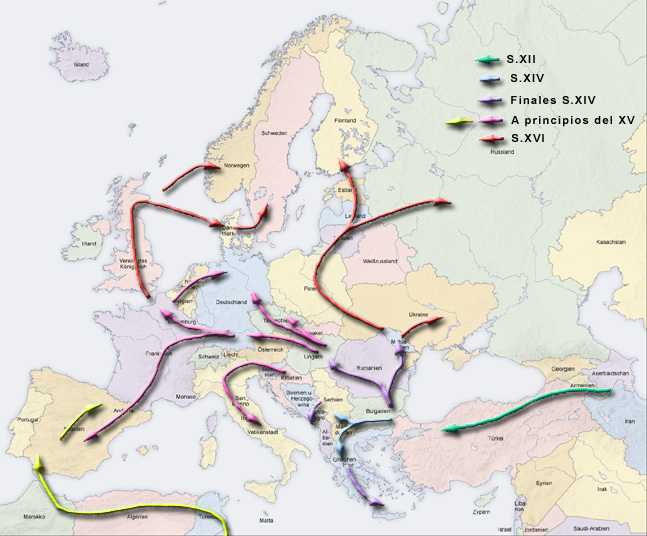
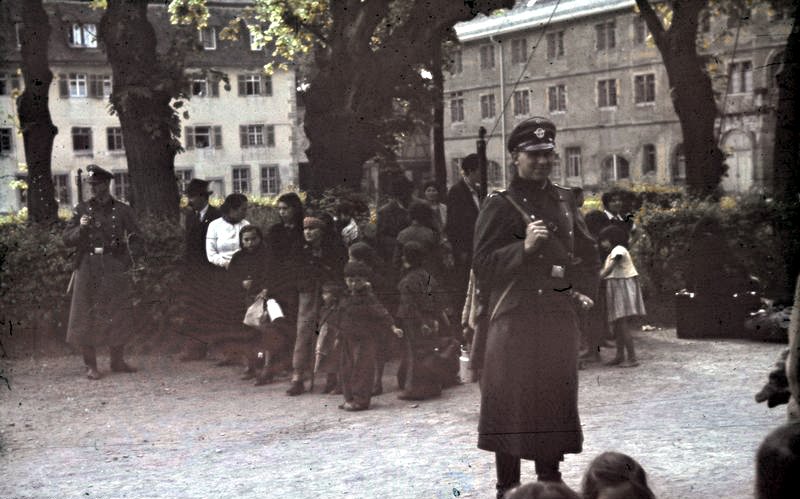
The migration of the
Romanis through the Middle East and Northern Africa to Europe/ Sinti
and Roma about to be deported from the German town of Asperg, 22 May
1940 (Bundesarchiv R 165 Bild-244-52, Asperg, Deportation von Sinti und Roma)
◎ソフィー・エーデルハルトもまた戦争犯罪
を認定されることなく、戦後も犯罪学、犯罪遺伝学研究をチュービンゲン大学で継続しておこなうことができた。
◎Rassenhygienische und bevölkerungsbiologische Forschungsstelle 人種衛生学人口生物学研究センター
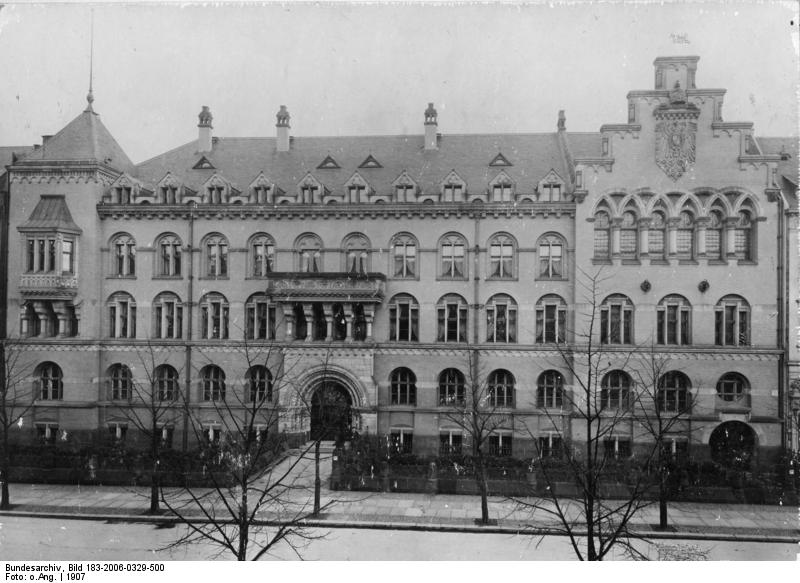
ベルリンの帝国保健省の本館(1907年)は、ク
ロップストック通りのハンサヴィアーテルにあった。
+++
Links
リンク
文献
その他の情報


